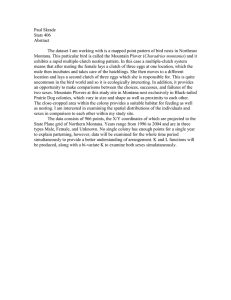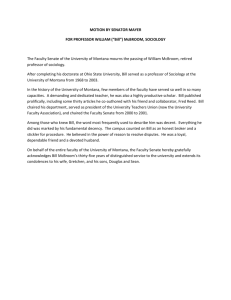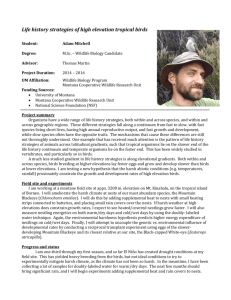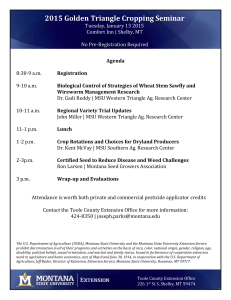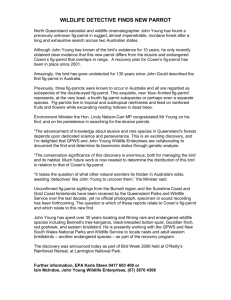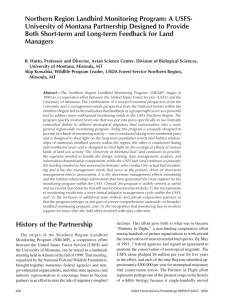Avian Science Center Senate Recommendation A. Written Report
advertisement
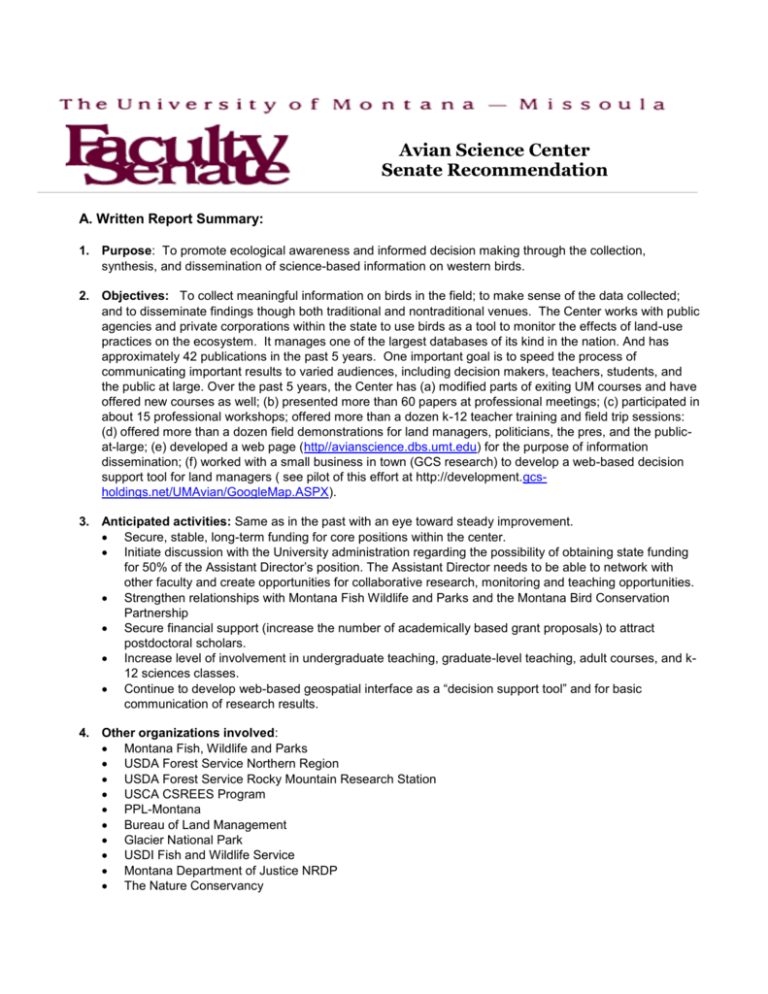
Avian Science Center Senate Recommendation A. Written Report Summary: 1. Purpose: To promote ecological awareness and informed decision making through the collection, synthesis, and dissemination of science-based information on western birds. 2. Objectives: To collect meaningful information on birds in the field; to make sense of the data collected; and to disseminate findings though both traditional and nontraditional venues. The Center works with public agencies and private corporations within the state to use birds as a tool to monitor the effects of land-use practices on the ecosystem. It manages one of the largest databases of its kind in the nation. And has approximately 42 publications in the past 5 years. One important goal is to speed the process of communicating important results to varied audiences, including decision makers, teachers, students, and the public at large. Over the past 5 years, the Center has (a) modified parts of exiting UM courses and have offered new courses as well; (b) presented more than 60 papers at professional meetings; (c) participated in about 15 professional workshops; offered more than a dozen k-12 teacher training and field trip sessions: (d) offered more than a dozen field demonstrations for land managers, politicians, the pres, and the publicat-large; (e) developed a web page (http//avianscience.dbs.umt.edu) for the purpose of information dissemination; (f) worked with a small business in town (GCS research) to develop a web-based decision support tool for land managers ( see pilot of this effort at http://development.gcsholdings.net/UMAvian/GoogleMap.ASPX). 3. Anticipated activities: Same as in the past with an eye toward steady improvement. Secure, stable, long-term funding for core positions within the center. Initiate discussion with the University administration regarding the possibility of obtaining state funding for 50% of the Assistant Director’s position. The Assistant Director needs to be able to network with other faculty and create opportunities for collaborative research, monitoring and teaching opportunities. Strengthen relationships with Montana Fish Wildlife and Parks and the Montana Bird Conservation Partnership Secure financial support (increase the number of academically based grant proposals) to attract postdoctoral scholars. Increase level of involvement in undergraduate teaching, graduate-level teaching, adult courses, and k12 sciences classes. Continue to develop web-based geospatial interface as a “decision support tool” and for basic communication of research results. 4. Other organizations involved: Montana Fish, Wildlife and Parks USDA Forest Service Northern Region USDA Forest Service Rocky Mountain Research Station USCA CSREES Program PPL-Montana Bureau of Land Management Glacier National Park USDI Fish and Wildlife Service Montana Department of Justice NRDP The Nature Conservancy Plum Creek Timber Company Big Hole Advisory Council Montana Natural History Center Bullitt Foundation UM Foundation 5. Reporting line: The Center reports directly to the Associate Dean of Biological Sciences, and from there through the Dean of the College of Arts and Sciences to the Provost and Research Office. The Center has an Indirect Cost Return agreement with Research and Sponsored Programs, CAS, and DBS. 6. Relationships with institutional mission and contribution to academic programs: The mission of the Avian Science Center fits well within the broader mission of the University by (1) providing a valuable applied research and monitoring service to the state; (2) developing and improving coursework that serves primarily students in the natural sciences; (3) engaging students in the theoretical and practical issues surrounding the monitoring of wildlife populations; (4) managing a large, multi-agency data set taken from across the entire region; (5) facilitating the publication of articles based on such data sets; and (6) establishing a science-based form of service, information dissemination, and outreach to the citizens of Montana. a) Relationship between center personnel and academic units The Director (Hutto) is a regular faculty member in the Organismal Biology and Ecology program within the Division of Biological Sciences b) Research performance As reflected in the number of publications, the research performance of center staff is high. c) Performance review mechanism The formal annual faculty review process within DBS captures most of the directors work with the Center. Performance review and salary calculations of ASC staff are achieved through normal classified staff procedures. 7. Similar programs: Organizations that do similar work with birds are Rocky Mountain Bird Observatory, Idaho Bird Observatory, Great Basin Bird Observatory, Klamath Bird Observatory, Point Reyes Bird Observatory. These organizations operate independently of academic institutions. 8. Budget: a. 1. Current faculty and percentage of time: Richard Hutto, Director (.75FTE) Erick Green (.1FTE ) Current staff: Kristina Smucker, Assistant Director (1.0 FTE) Anna Noson, GIS Specialist (1.0 FTE) Megan Fylling, Program Coordinator (1.0FTE) Seasonal Field Technicians (part-time) Work-Study students ( part-time) 2. Need and cost for new faculty (next five years): Postdoctoral Scholar 3. Need for other personnel: b. Use and anticipated needs (next five years) of University Resources: 1. Library: Met through electronic access to professional journals 2. Technology/equipment: The Centers telecommunication needs are growing because of increased video-conference meetings. The Center plans to offer webinars and will continue to develop other web-based forms of communication, including access to data an to geospatially based decision support tools. Cost is anticipated to be $20-30K/year. 3. Facility and space: c. Source of Funding (Provide figures for the last fiscal year): See Center Review Budget Form B. Review and Approval Process 2. The Faculty Senate through its Chair, who in turn shall distribute it to ECOS and other committees, and approve or disapprove the proposal by a vote of the Senate. Review in terms of Scope as stated in academic policy 100.0 To provide instruction, scholarship, or service to the University, state or world by: (1) focusing attention on an area of strength and/or addressing a critical issue, or (2) facilitating collaborative, multidisciplinary endeavors to combine resources from several programs or institutions to address issues of common interest. Review in terms of the University’s mission. Comments: The AS Center is focused on obtaining meaningful information on birds in the field, to interpret the data, and to disseminate the data to the public through traditional and non-traditional venues. Does ECOS/Faculty Senate consider this center controversial? The AS Center does not engender controversy. While it may propagate ecological positions, there appears to be a balanced approach to these issues. Is the relationship with academic units beneficial? Absolutely. Drs. Hutto and Greene are Professors in the Division of Biological Sciences. They bring the Center’s activities, which are extensive, in a tangible way to UM students. through course work, laboratories and research opportunities. The AS Center interacts with many local, State and Federal agencies, bringing visibility and distinction to UM. Is the program revenue neutral or does it consume more resources than it generates? If so, is the use of University resources justified? The AS Center is funded ($424,247 current funding) by grant-generated funds. The Center anticipates this funding to continue for the next five years. Is the entity making progress toward objectives? The AV Center appears to be meeting its objectives through its teaching (undergraduate and graduate), outreach via interaction with manifold agencies, and web-based communications Recommendation: The Center is well described in the Periodic Review. The Center has met or exceeded all of its goals. It is strongly recommended that the Center continue to enjoy the support of the Faculty Senate. Justification: The Center is well justified. The Center has been very active in research, teaching, outreach and communication. Dr. Hutto and colleagues have successfully supported the Center with grant funding, which should continue in the future.
